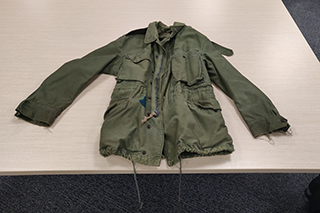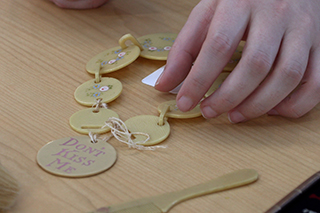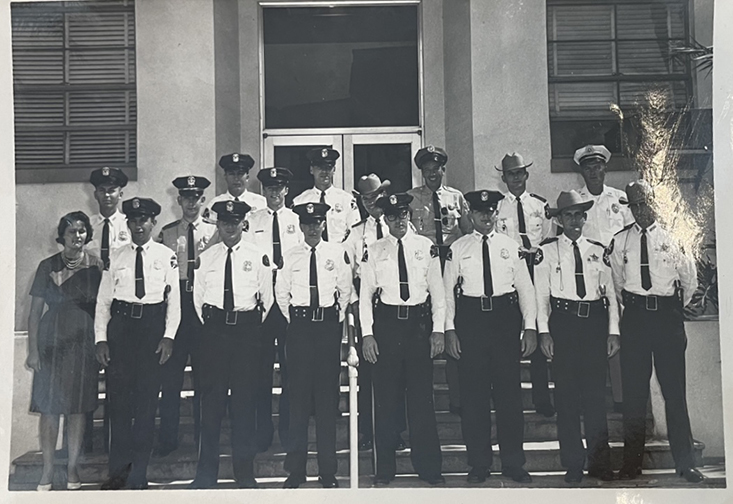By Sarah Sell, University Communications and Marketing
When Helen Sweatt submitted an old photo of herself to USF St. Petersburg’s History Department in September of 2023, its historical significance initially went unnoticed. The picture from the 1960s showed Sweatt, one of St. Petersburg's first female police officers, standing among a group of male police officers who were wearing uniforms and hats.
"I didn't identify her as a police officer in the photo because she didn't have a uniform. She was wearing a dress, pearls and heels. I thought she was the secretary," said Erin Stewart Mauldin, the John Hope Franklin Professor of Southern History at USF St. Petersburg.
The photo showing the early history of gender integration of the City of St. Petersburg Police Department would go on to spur undergraduate historical research.
Reviewing artifacts for her Historical Methods and Materials class, Mauldin chose the intriguing photo as part of her first-ever History Harvest held at the Nelson Poynter Memorial Library. Community members were asked to bring their family heirlooms and participate in a conversation with students about the object's significance and meaning.
Sweatt's photo inspired Viktoria Talariko to research a topic that she believes historians have typically ignored: how women's roles in law enforcement have changed over the last 100 years.
"The biggest thing I took away from Helen's interview was that she never expected to be treated equally when hired," said Talariko, a history major at USF St. Petersburg. "She didn't have a uniform, she didn't have a badge, she didn't have a hat like all the other officers. She was in normal women's clothes, like a skirt, because the department didn't issue police uniforms to women until the 70's."
In her performance review, Sweatt was told she was an excellent policewoman; her only handicap was that she was not a male. The biased remark came early in her career, but due to her own determination and advances in women's rights, she was eventually promoted to lieutenant and retired in 1990 after 27 years of service.
Talariko concluded that historical literature about women in law enforcement is limited. She found only two or three scholars writing books about it.
"I think it's amazing that we were able to define such a big gap," Mauldin said. "Victoria was able to make an original contribution to historical literature because we had an object from someone in the community. It broke new ground at the undergraduate level."
In addition to Sweatt's photo, the History Harvest received old letters, art pieces, clothing and jewelry. Students researched topics related to music, medicine, film, architecture and military history.

Military jacket worn by a member of the 101st Airborne Division in the 1950s
Jack Connelly chose to explore the story behind a military jacket worn by Bobby Hughes, a member of the 101st Airborne Division who was sent to Little Rock, Arkansas, to assist with racial integration.
Hughes is the uncle of Julie Buckner Armstrong, a civil rights and southern literature scholar and professor at USF. She told Connelly that her uncle doesn't remember much about the events despite it being an important part of history.
President Eisenhower ordered the 101st Airborne Division to the city in 1954 to ensure the safety of the "Little Rock Nine," the first African American students to enter Little Rock's Central High School.
Although a significant event in the civil rights movement, Connelly concluded that Hughes didn't remember the mission because it was a departure from his typical military duties, and he didn't realize how important it was to history at the time.
"I think integration in our schools is under-researched, and there's a lot more that could be learned," said Connelly, a history major at USF St. Pete. "I had trouble finding information because there's not as many first-hand accounts of the event. I think it's important for future students to know about this piece of history because it's not that long ago."

Pendant worn by infants in 1920s and 1930s to prevent the spread of Tuberculosis
Lorena Marins chose to research a "Don't Kiss Me" necklace donated to the St. Petersburg Museum of History that was never archived. The individual pendants were made in the late 1900s in response to the nationwide Tuberculosis (TB) outbreak. They were worn around babies' necks to stop the spread of tuberculosis.
Marins determined that the museum's necklace was likely handmade and probably came from a wealthy family who gave it to the museum. Her project revealed racial disparities in rates of infection and mortality from TB in the community.
"I've never done anything like this before," said Marins, a history major on the St. Petersburg campus. "Having the community here and being able to talk about their keepsakes and antiques is really interesting.”
“The students engaged in research at a deeper level because the topic was built in, Mauldin added. “I can’t tell you what a delight it is to help students make truly original arguments at their age.”
Another History Harvest is planned for the fall 2024 semester where USF will partner with the St. Petersburg Museum of History. The community event will allow students to continue conducting research into the historical significance of our community’s artifacts.
